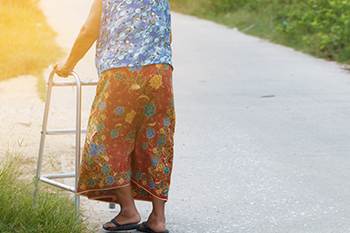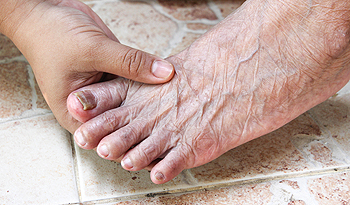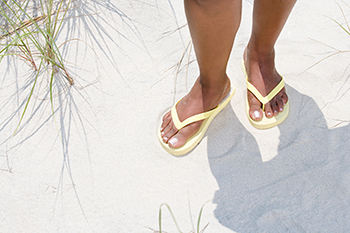November 2022
Falling Episodes May Be Prevented

Falling can happen to people of all ages, and it is not just limited to seniors. There could be existing medical reasons why people may fall, including muscle weakness, difficulty in walking, and poor balance. The feet are often affected when a fall happens, and it can result in a broken toe or foot. Additionally, there are environmental factors which can cause an individual to fall. When fall prevention methods are practiced, the risk of falling may be greatly reduced. These can include improving lighting in the living area, removing worn rugs from the steps, and ridding existing clutter from the floors. People who have had previous falls may refrain from completing daily activities for fear of falling again. This may be alleviated as the body becomes stronger when a gentle exercise program is performed. Additionally, having regular physical and eye examinations are beneficial in updating existing medications and eyeglasses. Many people find it helpful to install grab bars in the shower and toilet area which help to provide stability. If you would like to know more about effective fall prevention techniques, please confer with a podiatrist who can provide you with accurate information.
Preventing falls among the elderly is very important. If you are older and have fallen or fear that you are prone to falling, consult with one of our podiatrists from North Bay Ankle & Foot Center. Our doctors will assess your condition and provide you with quality advice and care.
Every 11 seconds, an elderly American is being treated in an emergency room for a fall related injury. Falls are the leading cause of head and hip injuries for those 65 and older. Due to decreases in strength, balance, senses, and lack of awareness, elderly persons are very susceptible to falling. Thankfully, there are a number of things older persons can do to prevent falls.
How to Prevent Falls
Some effective methods that older persons can do to prevent falls include:
- Enrolling in strength and balance exercise program to increase balance and strength
- Periodically having your sight and hearing checked
- Discuss any medications you have with a doctor to see if it increases the risk of falling
- Clearing the house of falling hazards and installing devices like grab bars and railings
- Utilizing a walker or cane
- Wearing shoes that provide good support and cushioning
- Talking to family members about falling and increasing awareness
Falling can be a traumatic and embarrassing experience for elderly persons; this can make them less willing to leave the house, and less willing to talk to someone about their fears of falling. Doing such things, however, will increase the likelihood of tripping or losing one’s balance. Knowing the causes of falling and how to prevent them is the best way to mitigate the risk of serious injury.
If you have any questions, please feel free to contact our offices located in Petaluma and Sonoma, CA . We offer the newest diagnostic and treatment technologies for all your foot care needs.
Reduced Fat Pads May Lead To Unwanted Foot Conditions

Many people experience various foot conditions during their lifetime, and this may be prevalent among elderly people. Reasons this can happen may include general weakness, a change in walking style, or balance difficulties. After many years of walking and standing, it is not surprising that seniors may develop unwanted foot conditions. These can include toenail disorders, bunions, hammertoe, and corns. The feet have fat pads that provide shock absorption to the body, and these may decrease as the aging process occurs. This can lead to forcing other parts of the foot to absorb the pressure which has no protection, causing pain and discomfort. Poor circulation is a common ailment among elderly people and can result in feet that become numb. It is beneficial for seniors to implement simple practices into their daily routines that can protect their feet. These can include washing and drying the feet, followed by looking at the soles of the feet in a mirror for existing cuts and scrapes. Wearing the proper shoes will allow the toes to have ample room to move freely, and this can help prevent bunions and hammertoe. If you would like more information about how to care for an elderly person’s feet, please consult with a podiatrist who can offer you helpful tips.
Proper foot care is something many older adults forget to consider. If you have any concerns about your feet and ankles, contact one of our podiatrists from North Bay Ankle & Foot Center. Our doctors can provide the care you need to keep you pain-free and on your feet.
The Elderly and Their Feet
As we age we start to notice many changes in our body, but the elder population may not notice them right away. Medical conditions may prevent the elderly to take notice of their foot health right away. Poor vision is a lead contributor to not taking action for the elderly.
Common Conditions
- Neuropathy – can reduce feeling in the feet and can hide many life-threatening medical conditions.
- Reduced flexibility – prevents the ability of proper toenail trimming, and foot cleaning. If left untreated, it may lead to further medical issues.
- Foot sores – amongst the older population can be serious before they are discovered. Some of the problematic conditions they may face are:
- Gouging toenails affecting nearby toe
- Shoes that don’t fit properly
- Pressure sores
- Loss of circulation in legs & feet
- Edema & swelling of feet and ankles
Susceptible Infections
Diabetes and poor circulation can cause general loss of sensitivity over the years, turning a simple cut into a serious issue.
If you have any questions please feel free to contact our offices located in Petaluma and Sonoma, CA . We offer the newest diagnostic and treatment technologies for all your foot and ankle needs.
Warming Up Before Running May Prevent Running Injuries

Incurring a running injury can ruin any day for the avid runner. There are simple methods that can be done that may help to prevent running injuries. The importance of warming up and cooling down before and after running is crucial in keeping the muscles flexible. This is necessary for keeping the tendons and ligaments healthy as running is practiced. It is beneficial to pay attention to the body, and foot pain for any reason may need prompt medical attention. Existing foot pain may cause the body to compromise on gait and balance, and there are three key factors that experienced runners implement to prevent injuries. A muscle’s potential to reach its full range of motion and flexibility can be increased when soft tissue elasticity is increased. Performing simple stretches can improve joint mobility, in addition to running becoming easier. Muscle activation is needed while running, and this is done by improving tissue elasticity and joint mobility. For additional tips on how running injuries can affect the feet and how to prevent them, please confer with a podiatrist.
All runners should take extra precaution when trying to avoid injury. If you have any concerns about your feet, contact one of our podiatrists of North Bay Ankle & Foot Center. Our doctors will treat your foot and ankle needs.
How to Prevent Running Injuries
There are a lot of mistakes a runner can make prior to a workout that can induce injury. A lot of athletes tend to overstretch before running, instead of saving those workouts for a post-run routine. Deep lunges and hand-to-toe hamstring pulls should be performed after a workout instead of during a warmup. Another common mistake is jumping into an intense routine before your body is physically prepared for it. You should try to ease your way into long-distance running instead of forcing yourself to rush into it.
More Tips for Preventing Injury
- Incorporate Strength Training into Workouts - This will help improve the body’s overall athleticism
- Improve and Maintain Your Flexibility – Stretching everyday will help improve overall performance
- “Warm Up” Before Running and “Cool Down” Afterward – A warm up of 5-10 minutes helps get rid of lactic acid in the muscles and prevents delayed muscle soreness
- Cross-Training is Crucial
- Wear Proper Running Shoes
- Have a Formal Gait Analysis – Poor biomechanics can easily cause injury
If you have any questions, please feel free to contact our offices located in Petaluma and Sonoma, CA . We offer the newest diagnostic and treatment technologies for all your foot care needs.
Wearing Flip Flops Can Be Harmful to the Feet

Wearing flip-flops during the warmer months is simple, stylish, and convenient. Despite these fun facts, they can wreak havoc on your feet. Foot pain may gradually develop when flip-flops are frequently worn. Most flip-flops don't have arch support, and shock absorption is minimal. Additionally, they are not sturdy shoes, and the heels are not cushioned. The toes work hard to keep the flip-flops securely on the feet, and hammertoe may be a foot condition that develops as the toes bend to keep the shoe from slipping off. Flip-flops are designed in different styles, and it is suggested to choose sandals that have a back strap. This may help the toes to maintain balance instead of gripping the front of the shoe to stabilize the foot. If you have questions about what type of flip-flops to purchase, please confer with a podiatrist who can address any concerns you may have.
Flip-flops can cause a lot of problems for your feet. If you have any concerns about your feet or ankles, contact one of our podiatrists from North Bay Ankle & Foot Center. Our doctors will assist you with all of your foot and ankle needs.
Flip-Flops and Feet
Flip-flops have managed to become a summer essential for a lot of people. While the shoes may be stylish and easy to slip on and off, they can be dangerous to those who wear them too often. These shoes might protect you from fungal infections such as athlete’s foot, but they can also give you foot pain and sprained ankles if you trip while wearing them.
When Are They Okay to Wear?
Flip-flops should only be worn for very short periods of time. They can help protect your feet in places that are crawling with fungi, such as gym locker rooms. Athlete’s foot and plantar warts are two common fungi that flip-flops may help protect your feet against.
Why Are They Bad for My Feet?
These shoes do not offer any arch support, so they are not ideal for everyday use. They also do not provide shock absorption or heel cushioning which can be problematic for your feet. Additionally, you may suffer from glass cuts, puncture wounds, and stubbed toes since they offer little protection for your feet.
More Reasons Why They Are Bad for Your Feet
- They Slow You Down
- May Cause Blisters and Calluses
- Expose Your Feet to Bacteria
If you have any questions, please feel free to contact our offices located in Petaluma and Sonoma, CA . We offer the newest diagnostic and treatment technologies for all your foot care needs.
Morton’s Neuroma Is Treatable

Morton’s neuroma is the thickening of the tissue that surrounds the digital nerve leading to the ball of the foot between the 3rd and 4th toes. Wearing high heels, flip-flops, or any shoes that are ill-fitting can increase the pressure on the toes and ball of the foot and make the condition worse. Activities that over-pronate the foot, such as walking barefoot in sand, or high-impact activities, such as jogging, are likely to increase pain with Morton’s neuroma. Walking can exacerbate the discomfort of the ailment but if the foot is protected and relieved from pressure, it can be continued. Shoes that provide a heel that is higher than the toes can reduce suffering. Beyond changing footwear, decreasing activity, massage, stretching, and using metatarsal insoles can help with this condition. If left untreated, Morton’s neuroma can lead to nerve damage. If you are experiencing foot pain and think you might be suffering from this condition, see a podiatrist who can help with a proper diagnosis and treatment options.
Morton’s neuroma is a very uncomfortable condition to live with. If you think you have Morton’s neuroma, contact one of our podiatrists of North Bay Ankle & Foot Center. Our doctors will attend to all of your foot care needs and answer any of your related questions.
Morton’s Neuroma
Morton's neuroma is a painful foot condition that commonly affects the areas between the second and third or third and fourth toe, although other areas of the foot are also susceptible. Morton’s neuroma is caused by an inflamed nerve in the foot that is being squeezed and aggravated by surrounding bones.
What Increases the Chances of Having Morton’s Neuroma?
- Ill-fitting high heels or shoes that add pressure to the toe or foot
- Jogging, running or any sport that involves constant impact to the foot
- Flat feet, bunions, and any other foot deformities
Morton’s neuroma is a very treatable condition. Orthotics and shoe inserts can often be used to alleviate the pain on the forefront of the feet. In more severe cases, corticosteroids can also be prescribed. In order to figure out the best treatment for your neuroma, it’s recommended to seek the care of a podiatrist who can diagnose your condition and provide different treatment options.
If you have any questions, please feel free to contact our offices located in Petaluma and Sonoma, CA . We offer the newest diagnostic and treatment technologies for all your foot care needs.




